
|   |

|   |
 e-mail: sunilkothari1933@gmail.com 13th edition of The Music Academy Dance Festival - Part 1 Photos courtesy: Music Academy January 28, 2019 Dance aficionados eagerly await the annual Dance Festival of The Music Academy that takes place from 3rd till 9th January for the past 12 years. 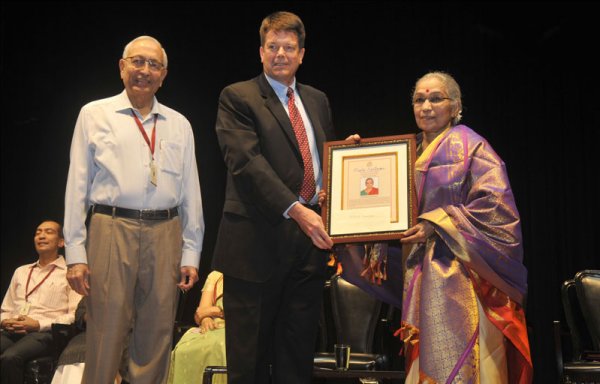 Shanta Dhananjayan receives Nrithya Kalanidhi award This year's Nrithya Kalanidhi award was conferred upon Shanta Dhananjayan for her distinguished career as a dancer, guru and choreographer. Her husband V.P. Dhananjayan was conferred the Academy's Sangita Kala Acharya award in 2005. The award now has been titled as Nrithya Kalanidhi award. Navia Natarajan 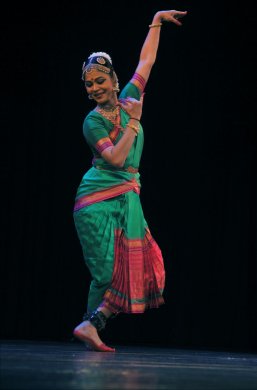 The opening performance was by Navia Natarajan who has appeared in the Music Academy dance festival earlier in the morning slot. She opened her recital with Uddharaka Krishna based upon the verses taken from Haribhakti Rasamrita Sindhu of Rupa Goswami and verses of Arjuna Bharadwaj, disciple of scholar Shatavadhani Ganesh, guided by Dr. Santosh Rajaraman for concept. Describing Krishna's attributes and divine form, she developed the theme further with how Krishna appears to different people. He is like an enemy to people who are afraid of him for their wrong deeds, like a cool breeze to a lover, and so on. To realize the essence of Krishna, she took the metaphor of Krishna lifting mount Govardhana, interpreting that when we are in trouble we take resort to the divine lord, lifting us from our mundane state to higher level. Well conceived with a metaphor, Navia brought a whiff of fresh air as it were to her interpretation. The music was composed by Rajkumar Bharati. The Tanjore Quartet varnam, Sami ninne kori nanura set to Ashtaragamalika and rupaka tala was choreographed by Navia with a different perspective. As a child when she had seen the lord she was overwhelmed by his form; when she grew up, she realized her own feelings of love for him and when mature, she realized that she could not live without him. In anupallavi, she employed various similes comparing lord with the sun and her as shadow, he as ocean and she a wave, he like a cloud and she as lightning. These sancharis were communicative and highly poetic. Alternating the sahitya with nritta, she embellished the varnam with exquisite utplavanas, jumps, landing lightly on the floor and completing teermanams in a flawless manner. The padam Picchaikku vandeero of Papanasam Sivan as taught to her by Bragha Besell stood out for her versatile abhinaya. The devotee asks Lord Shiva roaming around with a begging bowl, clothed in poor attire, and body besmeared with ash, the reason for appearing as a beggar. Is it because Kubera has left all his wealth to be protected from Ravana, and he is safeguarding it and therefore he wants to give an impression that he is a poor beggar? Or just because his son Ganapati is fond of too much food, that he begs and can offer him? The 'nindastuti' alankara is used by the poet to convey the opposite by painting Lord Shiva as a beggar, whereas he is the supreme Lord. In Yashodhara Vilapam which she has studied under Bragha Besell, she movingly created the despair and agony of Yashodhara, when Siddhartha left her when she was asleep. What could be the reason for his anger? 'How could he desert me, why are clouds and sun so happy? Am I to wail on the floor like a creeper whose support has disappeared? Will there ever be light in this house at dusk? Can the door tell me which way my husband left? Oh, my eyes could not warn me with a dream!' The agony expressed was palpable. Her chiseled nritta and expressive abhinaya enriched her presentation. Good command over basics are a hallmark and she enriches them with her deep understanding of the sahitya, its subtext and suggestions, vynajana. Shanthi Sutra 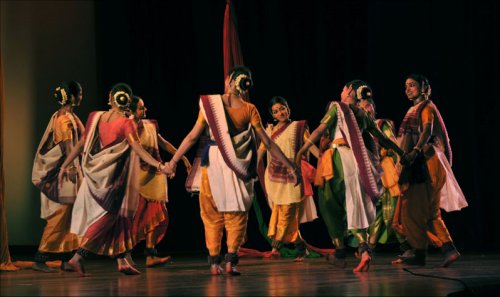 Remembering Mahatma Gandhi on his 150th birth anniversary and Rukmini Devi through the threads that connect them, Kalakshetra Foundation presented Shanthi Sutra-Thread of Peace. Conceived as a tribute to two visionaries of our land, one who spun the thread for our independence, the other who wove thread for our cultural renaissance, both paving the way of removing Avidya, ignorance, and creating a whole generation which sought independence under Gandhiji's movement had an excellent suggestion in dance production with simile of Gandhiji's idea of spinning for liberation manifested in recreation of handlooms, the revival of which had become Rukmini Devi's passion. The idea of Nai-Talim, basic education for all, reflected in the skilled training of fine arts in Kalakshetra, Sarva dharma samanvaya, emphasizing the paths followed by all religions lead to the same goal in vision of both persons. Gandhiji believed that extreme consumerism should not be encouraged and he believed in service to the nation. Rukmini Devi in her own way converted the sandy barren land into a haven of trees and plants, an institution in form of Kalakshetra which has contributed immense service to the environment and the nation. The artistic and creative director Revathi Ramachandran took up the challenging concept with inputs by the team of Kalakshetra dancers and musicians. Concept and script by her and assisted in dance choreography by Jyotsna Menon, Shaly Vijayan, K. Mohanan, Nirmala Nagarajan, Nandini Nagaraj, J. Sooryamurthy, Hari Padman, K.R. Lokesh Raj, K.P. Rakesh and music composition by K. Sai Sivakumar, the production succeeded in projecting the concept both in terms of dance and music. Divided into six scenes with refrain of Aaduraatai translating to a spinning wheel written by Namakkal Kavignar, it stitches together the tapestry that is woven on stage between the acts. In scene I, lamps are lit to remove darkness and ignorance. In Scene II dancers depict the warp and weft of cloth motifs of 'Annam', Rudraksha and 'Mayil' made on the fabrics. The revival of Khadi was crucial to India's struggle for Independence and a mere cloth was used as a weapon to unite the nation. The refrain 'Aaduraatai, Dance O charkha, rejoice, spin without stopping', visualized with movements of spinning wheel was captivating. The lighting, the back drop, the various colourful long scarves hung from the top, often held by dancers, weaving them in like dance of Maypole, and creating patterns was imaginative. In Gujarat, it is known as Gof rasa, and in Tamilnadu similar to pinnal kolattam, where dancers weave in and weave out performing without a hitch. It was imaginative to turn the scarves into a spinning wheel. The Bengali song by Rajnikanth Singh urging people to cover themselves in the coarse cloth of their mother nation and to pledge to never buy foreign goods, asking the women in villages to travel through the streets of the cities, never to be tired and work ceaselessly and sit in their homes and spin willingly was choreographed vividly. The succeeding scenes depict how art education was as important as academic education. The song Iyal Enna Ezhudiyum wove in and wove out varied art forms of literature, music, poetry, dance drama, sculpture, temples, ponds all leading to foster Indian national culture. People will come out and work together, cleaning the dirt left by the invaders. The songs describing all these were danced with enthusiasm and zest. The dancers often spoke in English to connect the scenes. In scene IV Narasimha Mehta's Gujarati song Vaishnavajan to tene re kahiye was used to convey the concept of non violence, Ahimsa. How Rukmini Devi displayed kindness to animals around her was suggested artistically. The folk song Dandalu Dandalu in Telugu depicting love for cattle, cultivators, worship of animals, was dovetailed by joyous movements for cultivation by farmers, and dance with drums. The refrain Aaduraatai mentioning that we shall put an end to the wrong deeds and hark people to pursue the righteous way of living led to the next scene of Sarva dharma sambhava. Scene V was conceived to explain how both Gandhiji and Rukmini Devi found truth in the name of Lord Rama. The song Bhajo re bhaiya Ram Govinda Hari by Kabir was choreographed leading to an excerpt of Paduka Pattabhishekam. The crossing of the river when Kaivat takes them across is an exquisite choreography by Rukmini Devi. As a matter of fact, Revathi and her associates have paid tribute to Rukmini Devi's series of Ramayana dance-dramas, weaving such excerpts in Shanti Sutra. Be it Kabir, Raidas, Tulsidas or any poems from Buddhisam, Islam, Christianity, all religions lead to one path of tolerance. The morning prayers under the Banyan tree every morning reflect these principles of sarva dharma sambhava. Those familiar with Gandhiji's life immediately get the resonances of his belief in these principles. The finale in scene VI once again lays stress on service to humanity which was of paramount importance to building the nation. The slogan Bharat Desh Hitaya reminds us of importance of service, compassion, and sensitivity to the environment around us. Athai was on a mission to nurture the land - to plant trees, saplings, and shrubs. The mighty Banyan tree is a testament of her love for flora and fauna; standing tall it is a symbol of synchrony between human life and nature. The scene endorses the song rendered in praise of Kalakshetra: 'Jayatu Jayatu Nityam Na: Kalakshetra Etat.' Let us lead our lives on Gandhian principles of peace and Ahimsa - Shanti Nilava Vendum. By any standard the dance-drama is long and some sequences of folk dances, of training given in Kalakshetra, which are repeated, can be edited. The team work was excellent, the musicians were at their best with their customary finesse, and the dancers displayed disciplined approach. The suspended scarves hanging from the top, the projection of visuals and the usage of scarves by the dancers were imaginative. Revathi Ramachandran and her colleagues deserve congratulations for putting across such an ambitious production, different from the familiar fare of mythology. I am a devout admirer of Kalakshetra and am delighted that the high standards set up by Rukmini Devi have been maintained. Day two Meera Sreenarayanan 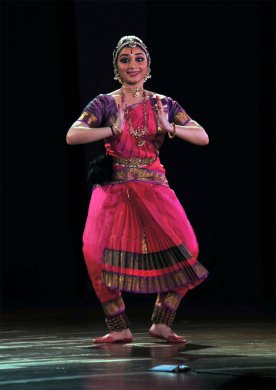 Meera Sreenarayanan currently training under Indira Kadambi, stole the show on the second morning with her mesmerizing Bharatanatyam recital, winning a standing ovation. She danced as if the stage belonged to her. What a royal way she moved, with boundless energy, and in varnam Danike Tagujanara in Todi, rupaka tala, a composition of Tanjore Sivananda Pillai, she praised Shivaji Maharaj in several befitting ways, enacting his prowess, majestic costumes, generosity, love for music and dance, excelling in nritta as well as abhinaya. While entering and leaving the durbar, she added subtle touches like offering salam, salutations to all, lest the audience forget that she was dancing in presence of a King in his court before other ministers and dignitaries! And she exited with a joyous winning smile. Here is a dancer who knows her powers, performs with supreme confidence and has the audience eating out of her hands! Watching her from the front row one had an added advantage of seeing her abhinaya clearly but her abhinaya and dance spoke volumes to even persons sitting at the back, creating magical moments. And that tiny slip of a girl rose to delightful artistic heights. Even if it is cliché to say 'A star is born,' it is true. During Natya Kala Conference at Sri Krishna Gana Sabha a few days earlier, Meera improvised on the spot to 'Comic relief', and had the audience roaring with laughter, enacting a comic situation of Ravana bragging of his power and falling flat on floor under the weight of the bow, a plight his servant found highly humorous! She indeed stole the show. And during the morning session with her abundant talent she once again proved that she can create that magic. Last year it was Parshwanath Upadhye who won a standing ovation with his impeccable performance. Here is another star on the contemporary dance scene creating waves. It was indeed a pleasure to see in Kshetraiyya's padam Choodare in Sahana raga and misra chapu tala, women gossiping and making faces at the nayika's arrogance and shamelessly going unto her lover Gopal, though married to a great man! Meera enacted various women in a trice including the nayika who could not care less! The cherry on the cake was ashtapadi Yahi Madhava yahi Keshava choreographed by Indira Kadambi. We have been watching it regularly in its Odissi and Bharatanatyam versions for years. We have been watching Radha's anguish at Krishna's returning after dallying with other gopis for a long time. It has been depicted in innumerable ways. In this depiction, Meera after making various complaints looked at Krishna, picked up a strand of hair from his body, turned her back on him holding the hair and moved away, the lights dimmed and Radha's agony was more eloquent with her silence, as she did not say anything further and just left! It was a brilliant touch. In Indian art in general in katha vastu, the story of known, what is challenging is how it is said, enacted, performed, presented. And depending upon the imagination and what is termed as manodharma, a dancer can astound the audience. Those fortunate ones who see that, carry that relish for long. Such touches also set a dancer apart from her contemporaries. Carry on, Meera, and delight your fans with equal joy whenever and wherever you perform. Bilva Raman 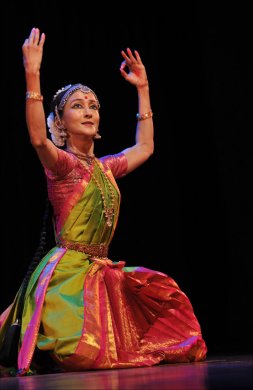 Bilva Raman, a disciple of Sri Rajarajeshwari Bharatanatya Kala Mandir and later on Kadirvelu Pillai, who followed Meera Sreenarayanan had a difficult job to engage the audience, as the latter had obviously lifted audience to another plane. Bilva went through her repertoire of Alarippu, Swarajathi in Husseni, Ye mayaladira faithfully, including the javali Marubaari taalalenuraa in Khamas as taught to her by Bragha Besell, with support of accompanying musicians - on nattuvangam Rakesh K.P, vocal by G. Srikanth, mridangam by V. Vedakrishnaram, violin by Easwar Ramakrishnan and flute by J.B Sruti Sagar, but it was obvious that her appearing after Meera eclipsed her performance. A. Lakshmanaswamy 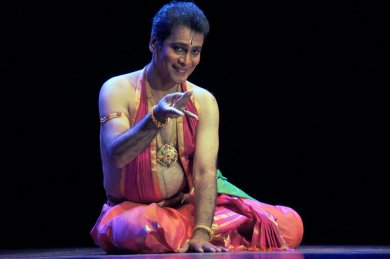 The evening belonged to two bright and mature dancers: In Bharatanatyam, A. Lakshmanaswamy, disciple of K.J Sarasa, and Mohiniattam dancer Dr. Methil Devika. Lakshmanaswamy was in pleasant form. With Tanjore Quartet's Ragamalika Jathiswaram in misra chapu tala, he at once established his credentials performing with meticulous precision and a pleasant expression, reminding us of K.J. Sarasa's style. He was in his element performing varnam, Intha chala melane, with lyrics and music by Meera Seshadri. The domestic quarrel between Lord Siva and consort Parvati had to be enacted, etching their character in a manner that one was to be convinced that being a man, Lakshmanaswamy would display Parvati's annoyance, anger, and not willing to reconcile even when lord beseeches her, sending messages with Nandi, serpent, deer and nothing works. The Lord of Kapalishwar temple does not succeed to win his consort back. In the sanchari, Ravana lifted mount Kailasa and threw it in the air, Parvati was frightened and clung to Lord Shiva, who embraced her and reassured her that she was safe. Lord Shiva pressed his toe and mount Kailasa was balanced. Lord blessed Ravana for his timely but inadvertent assistance to resolve the domestic quarrel. The varnam ended on that happy note. The abhinaya numbers, padam Yaro ivar yaro, and ashtapadi Kuru yadu nandana were enacted with delicacy. The sequence of Sita's playing with ball made of flowers and Rama's looking at her, their eyes meeting was delightfully performed. In Kuru yadu nandana, Lakshmanaswamy brought to fore his mukhajabhinaya, both for Radha and Krishna with subtlety enhancing shringara rasa. Tillana in Mandari raga and adi tala of Tanjore Quartet was danced in a joyous mood. Lakshamanaswamy's performance was full of old world charm. Compared to his performance two years ago, this performance was an improvement upon the previous one. Dr. Methil Devika 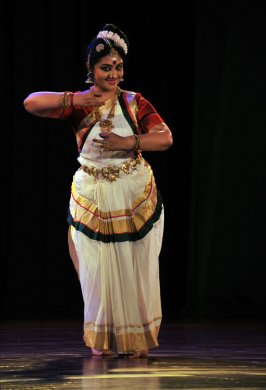 Dr. Methil Devika's exemplary Mohiniattam was noteworthy for the desi padam Peelipaattu (song of the feather) based upon the sthalapurana of Guruvayur and the local legend behind the origin of Krishnattam as a ritualistic art form that is performed inside the Guruvayur temple. King Manaveda Samudri goes to saint Bilvamangalam who is believed to have had a darshan of baby Krishna almost everyday, requesting the saint to help him get a darshan too. The saint says he can provided he stands behind the Elanji tree. Accordingly, Manaveda gets a beautiful vision of the baby but in his ecstacy, he attempts to hug the baby who vanishes. He hears a voice that says, 'You never asked for this. Are you so used to conquering everything?' Manaveda then realises the approach to Krishna is so different from his side and Bilvamangalam. As compensation, the baby leaves a feather and Manaveda gets his inspiration sitting under the Elanji tree to write the Krishnageeti, the text followed by the Krishnattam dancers. At every ecstatic moment, he would place a peacock feather on the crown of the character who plays Krishna. That's why in Kathakali such kireetas have so many feathers. The story in this presentation is seen through the eyes of a small boy who watches a Krishnattam performance and wants to know why the crown has so many feathers. The whole narration was performed with engaging abhinaya that brought the story alive. The padam was written by Devika's brother Methil Venugopal. In Muthuswami Dikshitar's Sree Kamalamba in Ahiri and rupaka tala, Devika created iconic images of the goddess replete with bhakti. The demon Vrtrasura had swallowed all the water from the earth including the lakes, rivers and the ocean. He was the asura that created drought. The item depicts how Devi annihilated Vrtrasura who had the boon that he could not be killed by anything wet or dry. The benign and ferocious forms of the goddess were evoked eloquently. The reference to the goddess seated on lotus and iconic image with Shri Chakra had several rich associations. Devika chose for abhinaya, Gita Govinda ashtapadi Kuru yadu nandana in Dhavalambari raga and misra chapu tala. After the love play, Radha requests Krishna to draw design with chandan paste on her breasts, place ornaments, waistband, draw kajal which were besmeared when he kissed her eyes, place flowers on her hair which fell off during the love play. The lajja, shyness and also as swadhinapatika nayika, Radha as depicted by Devika had her individual charm. Impersonating Krishna she brought out his character distinctly. Completing the ashtapadi with Jayadeva's Namamudra she like a devotee danced praising Lord Krishna, a departure from other dancers, who do not take final stanza for abhinaya. The finale Sadanchita, Nataraja Stotram by Patanjali in Punnagavarali and khanda chapu tala dwelt upon the dance of Shiva, when various gods accompanied him on various instruments. Patanjali begs of the lord to show his dance 'Soumya Tandava' when the entire prakriti, nature, performs with him; the peacock also dances joyously. It was performed by Devika with her natural charm and beauty of form as a Mohini. The soulful vocal rendition by Kottayam Jamaneesh Bhagavatar was replete with bhava. Instrumentalists accompanying Devika are all consummate musicians and gave her commendable support. Day three Medha Hari 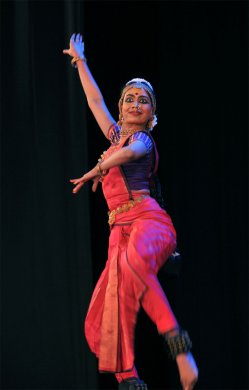 The morning session saw Anita Guha's disciple Medha Hari, bright young dancer who charmed the audience with her nritta and communicative abhinaya. Pandanallur Meenakshisundaram's varnam Intha Kopamelara in Todi and adi tala to the mellifluous singing by K. Hariprasad offered Medha scope for elaborating the majestic prowess and dignity of the Bhupati Govind alternating with scintillating nritta. The five flowery arrows were danced away with delicacy and its inevitable impact on nayika who longed for Setupati Bhupal. In Arunachal Kavirayar's Eppadi manam keertanam as taught to Medha by Bragha Bessell, Sita's pleadings to Rama leaving her behind and going to forest for fourteen years found felicitous expression that moved the spectators for the unbearable agony of Sita, who begged of Rama to take her with him. How can he leave her alone in an ocean? Such helplessness, when having taken seven steps in marriage, winning her after breaking the bow of Lord Shiva, was heartbreaking. Medha's complete involvement was touching. Sreelakshmy Govardhanan 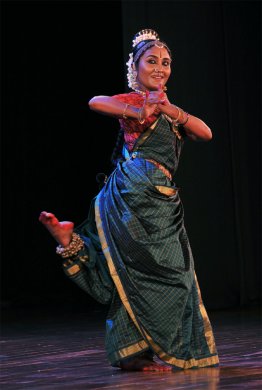 There was a buzz about Kuchipudi dancer Sreelakshmy Govardhanan. I had recently seen her in group choreography of hers at Konark Dance Festival. She has an endearing personality, so refreshing, unaffected, minus any airs, or over acting or trying to impress audience. Even when she introduced her items, her humility and charm was evident. Disciple of Pasumarthi Rattaiah Sarma, her Kuchipudi has an individual stamp. There is a certain indefinable innocence in her persona, which in turn embellishes the mugdha nayika she impersonates as she did in her patra pravesha daru of Usha from Usha Parinayam, which is so different from that of patra pravesha daru of say Satyabhama. The story is well known. Satyabhama is arrogant, confident, aware of her royal lineage, Usha in contrast is young nayika falling in love with a handsome prince in a dream. Sreelakshmy portrayed the experience of love making in gentle hues, overcome by bashfulness and inexplicable joy, the experience of love making in a dream and on waking up from it, the desire to beget the prince, the agony of not having him by her side, recalling how he sat on the bed, smiling, and remembering, Usha is overwhelmed by shyness. Sreelakshmy put both her palms on her face to express bashfulness, a sheer delight to watch. Even her vachikabhinaya, when she spoke of that handsome prince to her sakhi, was full of joy and now missing him was sheer pain. The passages of Kamadeva shooting flowery arrows and their falling on her eyes, lips, head, body and the excitement they generated was poetically enacted, with charming Kuchipudi movements, bobbing up the body, turning it from right to left and dancing in circle covering the stage, making for excellent visuals. The final plea to sakhi while falling on floor in a swoon 'Chitralekha, Chitralekha' was exquisite, highlighting her abhinaya. Another gem of abhinaya was ashtapadi when Radha had first encounter with Krishna, recalling it to her sakhi. The sweet nothings being cooed in her ears, while unfastening her lower garments, (shithilikrita jhaghana dukulam), receiving kiss, and the blissful becoming one with Krishna in tight embrace were enacted with such delicacy that it further heightened the poetry of Jayadeva replete with rasa. She had her own different eloquent take dancing this ashtapadi. She returned to herself as a devotee singing praise of Krishna ending the ashtapadi 'written by Jayadeva' about giving joy to whoever will ever listen to it and sing it. The team of musicians with vocal by Sangeeth Murali, mridangam by Kalamandalam Charudutt, nattuvangam by Suresh Nilemperoor and violin by K.P. Nandini gave her excellent support. The audience was won over by her unalloyed, joyous dancing but Sreelakshmy would do well to reconsider her costumes. They require good colour selection to stand out from the colour of the backdrop. Rama Vaidyanathan 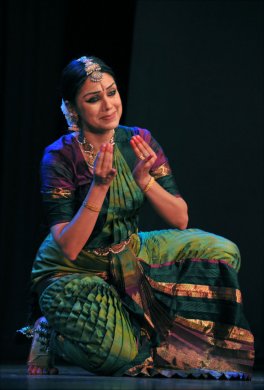 The evening belonged to Rama Vaidyanathan, who has been scaling artistic heights in her performances in recent years. This year she received Best Guru Award from The Music Academy. Rama opened her recital with a keerthanam Kovil konda Perumanay, by a descendent of the Tanjore quartet in Sri Raga and misra chapu tala. The devotee as an artist implores the lord of the big temple to give him the right knowledge to become a complete artist. He enters the premises and marvels at the grandeur of the temple. He is wonder struck by the sculptures, the dimension of the hall, feels the sense of rhythm and an intense sense of sruthi. Watching this, Rama as a devotee, led the audience inside the temple seeing it with wonder and devotion. The varnam by Swati Tirunal, Pannagendra sayana in Ashtaragamalika and rupaka tala dwelt upon nayika's shringara bhakti to Lord Padmanabha in eight different statements. Choreographed with imagination, Rama refers to the lotus eyes of the Lord, who is reclining on the serpent bed, Pannagendra sayana-seeing it she is mesmerized. The second statement was of the soft breeze which exhausts her. He with his jasmine bud like teeth looked irresistible. Her handsome lord need not be so indifferent to her as he knows that she is deeply in love with him. The third statement was about the chirping birds whose sweet cooing she was unable to bear as it enhanced her agony when she was only thinking of the lord. The fourth statement was about her friends mocking her for falling in love with the lord with decorations of serpents and besmeared with ashes, but to her, her lord was more handsome than even Kamadeva and she was steadfast in her love for him. The poet states that nayika refers to the fifth statement: 'I find momentary respite at night' when she fantasizes about being united with him. The delicate expressions of sheer happiness Rama registered as a consummate artist. The sixth statement is about the lord's luscious lips, which give her nectar, his exquisite yellow garment enhance his beauty. These all increase her agony to be united with him. The seventh statement is about her reflecting on his sidelong glances and she wants to be embraced by him. The eighth statement is about the lord's majestic gait like that of an elephant. The ardent love and bhakti were expressed by Rama with grace and devotion. Annamacharya's padam describing the state of love of Alamelumanga by the sakhis had several poetic similes. They speculate about the telltale marks on her face. They say that she looks like an open love letter, an unabashed declaration of love. See the stains of Kasturi on her lips, the lord having kissed her, her eyes are red and see the droplets of water on her face, the result of intense embrace. The shringara as Annamacharya has penned and sung in Tillang raga and misra chapu tala with refrain of 'Emakko chigruta dharmapal' was portrayed with restraint by Rama investing the padam with dignity and subtlety. In Pattabhiramayya's 'Ne netlu sahincu ne' javali in Paras raga and adi tala, Rama portrayed the nayika's helplessness at her lover's betrayal. The nayika pours her heart out to her sakhi saying that he is irresistible, handsome, charming, but look, he has walked into that other woman's house, stealthily opening the door. Nothing comforts me, music by playing veena, drawing a painting, nor any games playing with anyone in the garden, and when he knocks the door I am determined not to forgive him and would close the door on him. Rama was all feminine grace in this piece. The finale with O.S. Arun's Adi Shankara's verses in Megh raga for Ardhanareeswara ashtakam seems to attract majority of dancers to depict the lord's half side as male and the other as female. The approach is how to convey the two forms in contrasting manner. Kalidasa has described them with a simile as the union of the meaning and the word, 'Sabdarthau eva sampruktau, Parvati Parameshwarau'. The ornaments, the dhammila, hairdo of Parvati and the flowing jata of Lord Shiva, the fair colour of Champaka flower of Parvati's body and the ash besmeared body of Lord Shiva, Parvati adorned in silken garment and lord in naked form dressed in the garment of sky 'Digambaraya', Parvati having Mandara flower garland and Shiva having garland of skulls, to the two divine powers the devotee sings 'Namah Shivaya, Namah Shivaya'. Rama's performance revealed the beauty of the Bharatanatyam form. In case of her contemporaries, each one possesses admirable qualities, and the way each one presents with imagination and virtuosity is a sheer delight to watch. Rama has an excellent team of musicians. Their teamwork is exemplary. On nattuvangam S.Vasudevan, vocal by K.Venkateswaran, mridangam by Sumodh Sreedharan and violin by Viju Sivananda deserve special mention. Urmila Sathyanarayanan 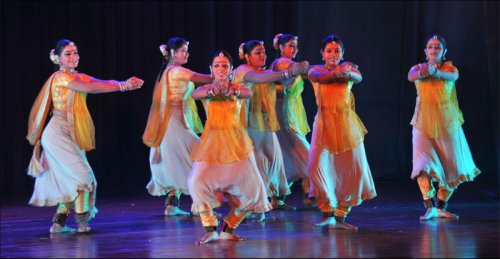 Much was expected from Urmila Sathyanarayanan, a gifted dancer, disciple of N. Dandayuthapani Pillai, K.J. Sarasa and Kalanidhi Narayanan. Unfortunately her group work 'Meera the Lotus of Prem' with her disciples of Natya Sankalpa did not meet expectations. Urmila missed out an opportunity to present Meera's story in a manner which would have been more dignified, less opulent and aesthetically pleasant. It would have been marvelous if she could have avoided the garish costumes, the loud commentary in English, and presenting more dignified persona of the Rana to whom Meera was married. The entire production suffered from excessive theatricality and left an unpleasant impression. Urmila must get a dramaturge, a sounding board, a designer with high aesthetic sense, and guidance from senior dancers that would help her raise her group productions to artistic level. Sometimes a production may not meet with success, but one expects better productions from a senior dancer like Urmila. 13th edition of The Music Academy Dance Festival-Part 2  Dr. Sunil Kothari is a dance historian, scholar, author and critic, Padma Shri awardee and fellow, Sangeet Natak Akademi. Dance Critics' Association, New York, has honoured him with Lifetime Achievement award. Post your comments Please provide your name and email id when you use the Anonymous profile in the blog to post a comment. All appropriate comments posted with name & email id in the blog will also be featured in the site. |